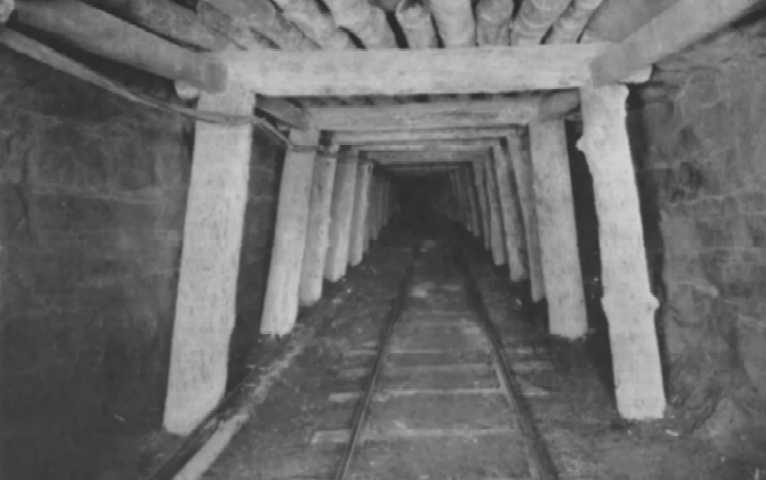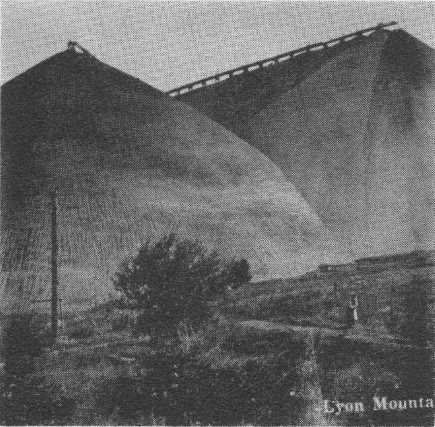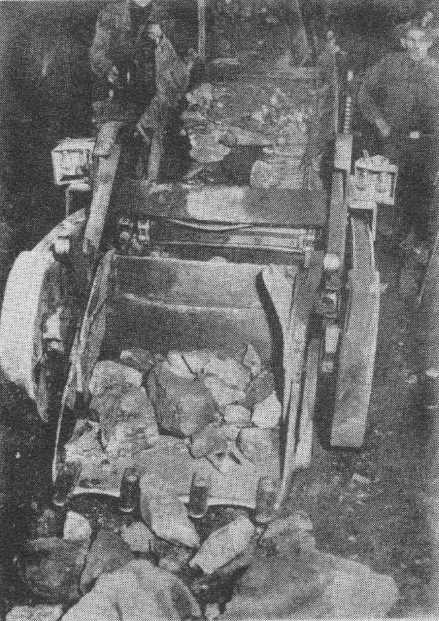Mining for Souls
Page 44
 Operations of the Chateaugay Division of Republic
Steel, at Lyon Mountain
by William J. Linney
Page 2
Operations of the Chateaugay Division of Republic
Steel, at Lyon Mountain
by William J. Linney
Page 2
 Main haulage drift - 1813 ft. level
Milling and Concentrating
Main haulage drift - 1813 ft. level
Milling and Concentrating
Chateaugay ore, as mined, contains 25 per
cent iron. By milling and magnetic concentration the iron content is brought
up to 68 per cent. Pure magnetite contains 72.4 per cent iron and 27.6 per
cent oxygen
When the ore comes from the mine it is 8 in. and
smaller in size. The fines, 1/2 in. and smaller, are screened out and conveyed
by an 18-in. belt conveyor to the fine silo. The coarse, 4 in. and larger,
is crushed to 3 in. by two 10 by 72-in. jaw crushers in the head house at
the top of the main hoisting shaft. Ore from the crushers, along with the
minus 1/2 in. which bypasses the crushers, is conveyed by a 30-in. belt
conveyor to a crushing plant, where it is passed over a double-deck screen.
That passing a 1/2-in. screen is conveyed to a fine silo; that passing a
2-in. screen and retained on a 1/2-in. screen is conveyed by a 30-in. belt
conveyor to a coarse silo; and that passing over a 2-in. screen discharges
into a 4-ft. cone crusher. The cone-crusher product is returned in closed
circuit to the double-deck screen at the top of the crushing plant.
Material from the coarse silo goes to two 36-in.
pulley-type electromagnetic separators which are set and regulated discard
all material containing less than 3 per cent iron. The iron-bearing material
retained by the separator is discharged to a 5«-ft. coile crusher set
to ~ in. which product is conveyed by a 30-in. belt conveyor to the sCI.oIl(tIly
crushing Iniuding.
Material from the mine silo is conveyed by an
18-in. belt conveyor to a lift-and-bucket-type elevator and discharged into
a dryer. This is a steel stack, 125 ft. high, lined with firetijick and
equipped with cast-iron baffles, heated by the hot gases from a chain
stoker, burning anthracite rice coal. 'Thoroughly dried. the material goes
on to a 24-in. steel conveyor and is discharged into the same 30-in. belt
conveyor that carried the product from the 5«,-lt. cone crusher.
The next step is to pass it over two 5 by
12-ft. doulde-deck vibrating screen , having 1/2-in. openings
on tile toll deck and 10-mesh openings on the bottom deck. The portion that
passes over the 1/2-in. screen is returned in closed circuit to the 51/2-ft.
cone crusher and the 10-mesh oversize goes to four 4 by 12-ft. vibrating
screens with 10-mesh openings. Oversize from the vibrating screens goes to
four 36-in.pulley-type magnetic separators which are set and regulated to
discard all material containing less than 3 percent magnetic iron. Magnetic
material retained by the separators is conveyed Ily 30-in. belt coliveyors
to a 9 by 16-It. (try rod mill, the product from which is returned in closed
circuit to the screens at the top of the building.
Ore passing the 10-mesh screens is sent to a 30-ft.
centrifugal air separator flIr taking out the minus-100-niesh material,
which is sent direct to wet magnetic separators. The coarse material from
the air separator, which is minus 10 mesh and plus 100 mesh, is conveyed
by a 30-in. belt conveyor direct to the bins over the dry magnetic separators
in the concentrating house.
Minus-lO-inesh dry material
now passes over sixteen 30-in. drum-type, electromagnetic separators, making
a concentrate containing 68 per cent iron or better, and a tailing containing
not more than 3 per cent magnetic iron. The middling from these separators
falls by gravity to sixteen separators of similar type directly below, which
also make a concentrate containing 611
per cent iron or better, and a taHing containing not more than 3 per cent
magnetic iron. Middling from these separators ii returned to the tins
at tll~ top of the building in closed circuit. Concentrate is sent to two
500-ton storage hins at the top of the sintering plant and the tailing goes
to the tailing p~e.
Because the minus-TOO-mesh material cannot be
efficiently separated on dry drum-type magnetic separators, it is sent to
wet inclined-belt magnetic separators which make a 70 per cent iron concentrate
and a tailing containing not more than 2 per cent magnetic iron. The concentrate
is sent to a filter and then to the storage bin above the sintering plant.
Ore tailing, or rock that has been separated from
the ore, has become a valuable by-product. Each commercial size is stored
separately in piles above a concrete tunnel, through which a 36-hi. belt
conveyor takes it to railroad cars for shipment to market. Hundreds of thousands
of tons of ore tailing was shipped in 1942.
The concentrating plant has a capacity for treating
efficiently 4500 long tons of crude ore in 24 hours, from which 1400 long
tons of concentrate containing 68 per cent iron is produced. Within
the next few inlIoths the concentrating mill will be changed
over entirely to the wet process, using wet inclined-belt magnetic separators.
Sintering the Concentrate
Sintering is accomplished by means of the
continuous process. The sinter machine is 6 ft. wide and 82 ft. long, comprised
of a series of grates known as pallets which are mounted on wheels for traveling
(In a continumis track
Concentrated ore is first mixed with about 51/2
per cent by weight of anthracite. The grade of fuel used is about
the size of granulated sugar, high in carbon and low in ash, and is known
as "anthrafine." As the fuel and concentrate are being mixed, by means of
a pug mill, a small amount of water is added as a temporary hinder. The mixture
of ore and fuel is spread evenly on the pallets of the sintering machine
to a thickness of about 71/2 in., and the fuel is immediately ignited as
it passes under an oil-heated ignition furnace comprised of refractory brick,
and a retort, or combustion chamber, suspended by a steel and cast-iron frame.
Combustion is assisted by a downward current of
air, drawn through the mixture or bed, the entire length of the machine,
by a large induced-draft fan with a capacity of 90.000 cu.ft. of air per minute.
The speed at which the machine travels is regulated so that, by the time
the material reaches the discharge end, the fuel is entirely burned out and
the process cmnpleted. The sinter is then discharged over a set of stationary
grizzly bars, spaced 1 iii. apart, which take out the lilies, allowing only
the coarse material to go to the railroad car for shipment. The lines are
returned, by means of an indined belt conveyor, and are lii~ \:ed
with the incoming feed to the sulterill machine.
The plant has an output capacity of 58 long tons
of sintered ore per hour, six days per week, and can be operated continuously
and efficiently 24 hours daily by suspending operations 8 hours each week.
 Tailings Piles
Tailings Piles
 Myers-Whaley shovel underground
Myers-Whaley shovel underground
Sources:
Adirondack Museum photos, Blue Mountain Lake, NY;
History of Clinton County, New York;
from History of Mining of Chateaugay
Ore and Iron Company.
Go to Page 1 of The History of Lyon
Mountain.
Go to Page 3 of The History of
Lyon Mountain.
Go to Mining History for The History
of Mining in the North Country.
Go to Page 5 of The History of Lyon
Mountain.(for article on Lyon Mt. and Mineville)
Go to Page 45 of Mining for Souls.
Back to Page 43 of Mining for Souls.
Go to Page 1 of Mining for Souls.(cover
page)
 Rod Bigelow
Box 13 Chazy Lake
Rod Bigelow
Box 13 Chazy Lake
Dannemora, N.Y. 12929
 rodbigelow@netzero.net
rodbigelow@netzero.net  BACK TO
THE HISTORY PAGE
BACK TO
THE HISTORY PAGE
 BACK TO BIGELOW
HOME PAGE
BACK TO BIGELOW
HOME PAGE





